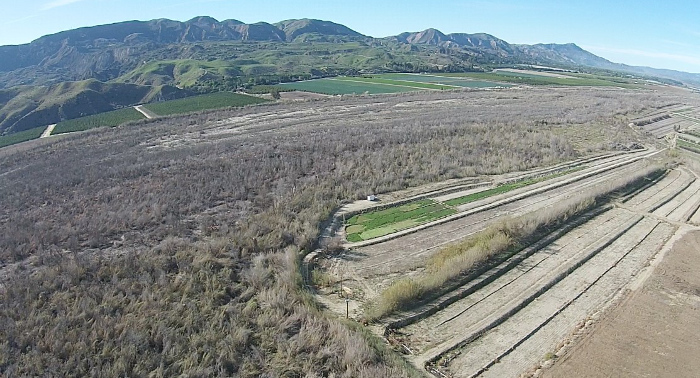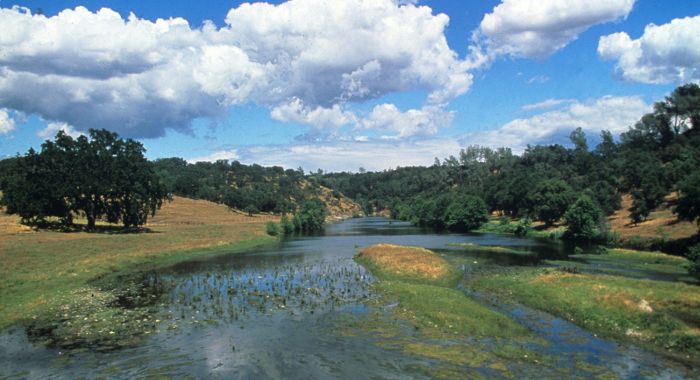In a normal year, groundwater accounts for 40 percent of California’s water supply. That number jumps to 60 percent during a drought. It’s also critically important for sustaining certain types of aquatic, terrestrial and coastal ecosystems.
Yet decades of unregulated groundwater withdrawal has compromised that ability to provide for people and nature. Wells dry up, water quality declines, and rivers, wetlands, and springs disappear.
To address this problem, California passed legislation requiring that groundwater basins be managed sustainably. We still face gaps, however, in our understanding of how to manage these basins to ensure the health of the ecosystems they support. Conservancy scientists are working with water managers and state agencies to close those gaps.


Kirk Klausmeyer, Jeanette Howard, Melissa Rohde, Charlotte Stanley
The first step to sustainably manage groundwater dependent ecosystems (GDEs) is to identify where they are. The Nature Conservancy developed a statewide spatial database that provides locations of…Laurel Saito, Bill Christian, Jennifer Diffley, Holly Richter, Melissa M. Rohde, Scott A. Morrison
In this paper, we describe minimum provisions for planning, managing, and monitoring groundwater in a manner that collectively can lower the risk of harm to groundwater-dependent ecosystems and…H. Scott Butterfield, T. Rodd Kelsey, and Abigail K. Hart, Editors
As the world population grows, so does the demand for food, putting unprecedented pressure on agricultural lands. At the same time, climate change, soil degradation, and water scarcity mean that…Erin Conlisk, Gregory H. Golet, Mark D. Reynolds, Blake Barbaree, Kristin Sesser, Kristen Byrd, Sam Veloz, Matthew E. Reiter
Highly mobile species, such as migratory birds, respond to seasonal and yearly changes in resource availability by moving among habitats. Understanding how they select among habitats is important for…Mary Kang, Debra Perrone, Ziming Wang, Scott Jasechko, Melissa M. Rohde
To ensure that California’s groundwater is sustainably managed in the future and over the long-term, current state definitions of what constitutes groundwater may need to be revised, according…Sophie S. Parker, Andy Zdon, William T. Christian, Brian S. Cohen, Maura Palacios Mejia, Naomi S. Fraga, Emily E. Curd, Kiumars Edalati, Mark A. Renshaw
This paper presents results from the Mojave Desert Springs research project, and discusses why the conservation of these groundwater-dependent ecosystems is so critical to biodiversity. The authors…M. Florencia Miguel, H. Scott Butterfield, Christopher J. Lortie
This meta-analysis provides a global synthesis of the which restoration practices – active vs. passive – are most successful at restoring plants, animals, and other ecosystem functions to…Maura Palacios Mejia, Emily Curd, Kiumars Edalati, Mark A. Renshaw, Roy Dunn, Daniel Potter, Naomi Fraga, Jenna Moore, Justin Saiz, Robert Wayne, Sophie S. Parker
This paper presents results from the Mojave Desert Springs research project. The authors used an environmental DNA (eDNA) technique to assess biodiversity at four naturally occurring springs. They…Melissa M. Rohde, Laurel Saito, Ryan Smith
In addition to benefiting humans, groundwater is a critical water supply to many ecosystems, providing a buffer during dry periods and critical habitat for rare and endemic species. Increasing…Benjamin P. Bryant, T R. Kelsey, Adrian L. Vogl, Stacey A. Wolny, Duncan J. MacEwan, Paul C. Selmants, Tanushree Biswas, H S. Butterfield
Irrigated agriculture has grown rapidly over the last 50 years, helping food production keep pace with population growth, but also leading to significant habitat and biodiversity loss globally. Now,…Samuel C. Zipper, Jennifer K. Carah, Christopher Dillis, Tom Gleeson, Ben Kerr, Melissa M. Rohde, Jeanette K. Howard, Julie K.H. Zimmerman
Using a newly developed tool for estimating streamflow depletion from groundwater pumping, this study examined the impacts of ongoing groundwater pumping on streamflow and aquatic ecosystems in the…Melissa M. Rohde, Sara B. Sweet, Craig Ulrich, Jeanette Howard
Groundwater plays an essential role in supporting freshwater species, riparian habitats, and migratory birds. These ecological communities, commonly referred to as groundwater-dependent…Houston Wilson, Hekia Bodwitch, Jennifer Carah, Kent Daane, Christy Getz, Theodore E. Grantham, Van Butsic
Cannabis has been an industry in the shadows for many decades and little studied. In partnership with U.C. Berkeley and U.C. Cooperative Extension, the Conservancy staff developed the first cannabis…Sandi Matsumoto, Melissa M. Rohde, Sarah Heard
Groundwater is a critical water supply around the world and is increasingly under threat from pumping that exceeds natural replenishment. Successful implementation of California's Sustainable…Rohde MM, Seapy B, Rogers R, Castañeda X, editors
Plant and animal species can rely on groundwater directly or indirectly for water, nutrients, and stable temperatures. The Critical Species LookBook is a compendium of 84 state and federally listed…Samuel C. Zipper, Tom Gleeson, Ben Kerr, Jeanette K. Howard, Melissa M. Rohde, Jennifer Carah, Julie Zimmerman
Reductions in streamflow from groundwater pumping can negatively impact water users and aquatic ecosystems but are challenging to estimate due to the time and expertise required to develop numerical…Kirk Klausmeyer, Falk Schuetzenmeister, Nathaniel Rindlaub, Tanushree Biswas, Melissa M. Rohde, Jeanette Howard
94,333 unique ecosystems depend on groundwater in California. GDE Pulse lets you see how they have changed over the last 30 years. Groundwater managers and environmental stakeholders often lack…